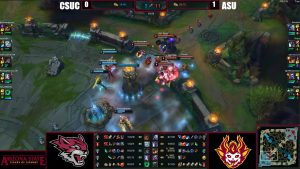- Slug: Sports-League of Legends, 900 words.
- 1 photo available
By Xavier Johnson
Cronkite News
PHOENIX – The first few weeks of the College League of Legends (CLoL) season pits elite teams against overmatched opponents in a tale of two experiences.
And neither is especially good for the esports teams involved as the top teams race against the clock to defeat their lesser opponents as quickly as possible – known as “speedrunning” – to take advantage of a tie-breaker that is based on time when teams are seeded in the postseason.
It’s a system that Arizona State League coach Dylan Shervill said isn’t ideal for his team or its opponents.
“This actually kind of sucks because we would want to play a comp that we can practice and that we can execute on. But we’re forced to play this style, where it’s almost like humiliating the other opponent,” Shervill said.
ASU League, which is currently 5-0 and tied with California Irvine atop the West Conference, is among the top teams in the country. The Sun Devils recently faced an overmatched California State University, Chico squad in the season’s first week and took the match in straight sets, including a team-record 11-minute, 32-second victory in Game 2.
The average ranked League of Legends game lasts between 25 and 30 minutes, so ASU outpaced that mark by more than 10 minutes. Their lightning-quick accomplishment isn’t out of the ordinary in the opening weeks of the season as teams look to put themselves in the best position to win postseason seeding tiebreakers.
Top squads make it a point to take advantage of the soft competition early in the tournament to win games as fast as possible, often running strategies that wouldn’t normally work against better teams, but are optimized for quick, decisive victories.
It’s a balance that Shervill said his team has to navigate while trying its hardest to win without disrespecting its opponents in the process. It also comes with its own dangers because execution is still of the utmost importance. Shervill said that top teams like Michigan State have lost games while attempting such speedrun strategies.
“You’re really playing with a double-edged sword, where if you want to try and run this comp, you also have to make sure you’re doing it effectively,” Shervill said.
With over 400 universities, CLoL is the largest tournament of its kind, officially run by the publisher of Riot Games. The tournament begins with a six week Swiss tournament bracket that puts teams against opponents with similar records each round. The field is too large for a round-robin round, so the Swiss bracket is used to determine where teams are seeded for the single-elimination postseason bracket.
The nature of the Swiss-bracket system, combined with the large number of teams in the main conferences in CLoL – West, East, North, South – inevitably leads to early weeks that are filled with mismatches.
Ties are broken in CLoL by match record, game record and fastest average win time. As teams advance through the bracket, the skill gap closes as teams face stiffer competition, which leads to longer games.
Thus, the early portion of the Swiss rounds puts pressure on the best teams to lower their average win time against the weaker teams.
“The collegiate schedule is packed, and we want to ensure our participants are students first, so we utilize win time for regular season tiebreaker games instead of requiring additional tiebreaker matches,” said J.T. Vandenbree, operations and championships lead for Riot Scholastic Association of America.
For some coaches, the existing tiebreaker rules incentivize unsportsmanlike play, considering that teams are forced to end games as quickly as possible.
“I compare it to teams who don’t try to run up the score in football,” Shervill said. “Like, you don’t want to run up the score if you can prevent it. If you happen to score, you happen to score. But in CLoL it’s almost encouraged. You just beat them as quick as you can because it’s just better for you.”id.
Sean Shannon, who is general manager of Supernova and former Grand Canyon University League of Legends coach, said the current tiebreaker rules are bad for esports. While mismatches do happen in other college sports, for instance when powerful Alabama steamrolls a smaller college in football, there aren’t the same kind of benefits for the losers in CLoL compared to NCAA competition.
Shannon pointed out that in college football, small schools are paid for playing against a powerful program. In League of Legends competition, the lesser teams aren’t getting paid and the better programs aren’t benefiting by quickly blowing out a bad team.
“The difference in college football, if ASU goes to play X and throws up 80, the bad school gets money,” Shannon said. “That’s not how it works in CLoL. There’s no benefit for higher teams to schedule their day to be done in an hour.”
Shannon said it would take a complete overhaul of the current CLoL system to solve some of these equity issues and have teams play more evenly matched games throughout the entire season. He said there’s no other sport where the top players in the world play in such wide skill gaps.
The RSAA is planning on revamping its system for the 2023 collegiate season, with scheduling changes that could also make the league easier to follow.
“One of our key goals is to lower matchup disparity, giving schools of all skill levels closer matches sooner and more often,” Vandenbree said.
For more stories from Cronkite News, visit cronkitenews.azpbs.org.
